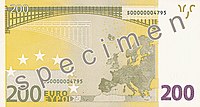200 euro note
| (Eurozone and Institutions) | |
|---|---|
| Value | 200 euro |
| Width | 153 mm |
| Height | 82 mm |
| Security features | Hologram patch with perforations, EURion constellation, watermarks, microprinting, ultraviolet ink, raised printing, security thread, matted surface, see through number, colour-changing ink, barcodes and serial number |
| Paper type | Cotton fibre |
| Years of printing | Since 1999 |
| Obverse | |
 |
|
| Design | Window in an Art Nouveau style |
| Designer | Robert Kalina |
| Design date | 3 December 1996 |
| Reverse | |
 |
|
| Design | Bridge in an Art Nouveau style and map of Europe |
| Designer | Robert Kalina |
| Design date | 3 December 1996 |
The two hundred euro note (€200) is the second-highest value euro banknote and has been used since the introduction of the euro (in its cash form) in 2002. The note is used in the 23 countries which have it as their sole currency (with 22 legally adopting it); with a population of about 332 million.
It is the second-largest note, measuring 153 x 82 mm, and has a yellow colour scheme. The two hundred euro banknotes depict bridges and arches/doorways in Art Nouveau style (19th and 20th centuries).
The €200 note contains several complex security features such as watermarks, invisible ink, holograms and microprinting that document its authenticity. In September 2011, there were about 178,838,200 €200 banknotes in circulation around the eurozone.
The euro was founded on 1 January 1999, when it became the currency of over 300 million people in Europe. For the first three years of its existence it was an invisible currency, only used in accountancy. Euro cash was not introduced until 1 January 2002, when it replaced the national banknotes and coins of the countries in eurozone 12, such as the Finnish markka.
Slovenia joined the Eurozone in 2007,Cyprus and Malta in 2008,Slovakia in 2009,Estonia in 2011,Latvia joined on 1 January 2014 and Lithuania joined on 1 January 2015.
The changeover period during which the former currencies' notes and coins were exchanged for those of the euro lasted about two months, from 1 January 2002 until 28 February 2002. The official date on which the national currencies ceased to be legal tender varied from member state to member state. The earliest date was in Germany, where the mark officially ceased to be legal tender on 31 December 2001, though the exchange period lasted for two months after that. Even after the old currencies ceased to be legal tender, they continued to be accepted by national central banks for ten years or more.
Notes printed before November 2003 bear the signature of the first president of the European Central Bank, Wim Duisenberg, who was replaced on 1 November 2003 by Jean-Claude Trichet, whose signature appears on issues from November 2003 to March 2012. Notes issued after March 2012 bear the signature of the third president of the European Central Bank, incumbent Mario Draghi.
...
Wikipedia
